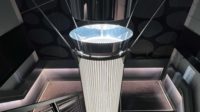Sun Valley, Idaho
When asked if his latest project, a vacation home in the Idaho resort town of Sun Valley, is at all based on a local vernacular, Tuscon-based architect Rick Joy bristles. “I don’t really think that way,” he says. Nevertheless, the starting point for the 7,900-square- foot house, built at the edge of a golf course and a brush-covered hillside, seems to have been a long, low-slung volume topped with an archetypal vernacular element: a gabled roof.
The configuration also provides his clients—an outdoorsy retired couple who had been visiting Sun Valley for decades—the best vantage points for taking in the rugged landscape. From the guest bedrooms (for their grandchildren and children) and from the living room, they can see the ski trails on Bald Mountain. From the kitchen and dining room, they are able to appreciate a set of sawtooth-shaped peaks. And from the master bedroom, they can practically reach out and touch a sage-covered hillock that rises just a few feet beyond a sliding glass door. A roof deck positioned above the intersection of the two wings is shielded from the golfers on the nearby course but affords a full panorama of the house’s surroundings. The twisting configuration, explains Joy, “is all about the views.”
The project’s biggest challenge, says the architect, was creating a building that is light on the land but is also rooted in it. He satisfied these seemingly incongruous goals by enclosing those parts of the house that are cut into the slope in rubble walls. The stone, granite from southern Idaho, is exposed inside and out.
The rest of the structure is clad with bronze-toned-steel roof and wall panels and is framed primarily in Douglas fir, but also includes exposed wide-flanged steel elements. “It was a little like adding onto an existing building,” says Joy of his strategy for combining the masonry walls and the lighter-weight framed system.
Indeed, the stone elements feel almost as though they’ve been there for a very long time, or are part of the terrain. Except when the ground is covered with snow, the granite’s browns, yellows, and silvers pick up the hues of the sage and other surrounding vegetation, much in the same way the rammed-earth houses Joy is known for seem to meld with their Southwest desert environs.
The forms of the Sun Valley House are far from outlandish. However, the cranked configuration made it demanding to build. But despite its tough geometry, the house is extremely well executed. Joy gives much of the credit to the project’s Seattle-based general contractor, Schuchart/Dow, and its managing partner, Jim Dow. The firm is currently working on houses designed by Olson Kundig, Lake Flato, and Bohlin Cywinski Jackson. “Jim goes out of his way to work on real architecture,” says Joy.
One example of a particularly exacting element is the roof on the western wing. The bend in its plan produced an almost imperceptible valley over the living room and necessitated a fanned configuration for the rafters, which in turn meant that no two were the same length, points out Dow. He estimates that carpenters were able to cut and install only about six rafters per day. The building has many other ingenious but tricky details, such as cast-on-site concrete lintels that support the weight of the stone above while appearing to float over the openings they frame. The stone walls also have remarkably crisp corners, the inherent roughness of the material notwithstanding. “Stone and wood can be quite rustic, but this is pretty refined,” says Dow.
Adding to the sense of refinement and precision are the approximately one-inch reveals that separate elements from each other: the cedar door and window frames from the stone, the stone from drywall soffits, and the soffits from the anigre millwork. The gaps are not purely aesthetic, however. Some function as supply and return vents for the forced-air mechanical system. It works in concert with radiant heating and cooling and 20 geothermal wells drilled 220 feet below the driveway. The performance of this climate-control system, which Dow describes as “complex but efficient,” is further improved by features such as the heavily insulated stone walls, 17 inches thick on average, and automated exterior shades that protect the living room’s west-facing bank of windows from solar gain.
On a recent winter day, when the mountains and the valley were covered with a blanket of snow, the house was quite comfortable, even cozy. “Cozy” applies not only to the indoor temperature, but also to the character of the spaces—a surprising outcome given the size and height of the ground- floor rooms (the ceilings soar to 20 feet in some places). Joy admits that the house, at almost 8,000 square feet, is larger than he generally prefers. But the clients wanted to be able to host family and friends, he explains. And he points out a second rationale for the scale: it matches the majesty of the landscape.
People
Architect:
Personnel in architect's firm who should receive special credit:
Structural engineer:
Landscape Architect:
Lighting Design:
General Contractor:
Renderings:
Photography:
Program:
CAD system, project management, or other software used: Size: 7,900 square feet Cost: withheld Completion date: October 2013 |
Products
Structural system:
Exterior cladding
Metal Wall Panels:
Wood:
Concrete:
Moisture barrier:
Radiant barrier:
Roofing
Windows
Glass:
Skylights:
Doors
Wood doors:
Pocket doors:
Garage Door:
Hardware
Cabinet Pulls:
Handrails:
Interior finishes
Paint:
Wood Paneling:
Wood Flooring:
Floor and Wall Stone:
Carpet:
Special interior finishes unique to this project:
Lighting
TRULY TRIMLESS
TRULY TRIMLESS
Task lighting:
Exterior:
Dimming System or other lighting controls:
Ceiling Fans:
Plumbing
PANTRY
PANTRY BATH
LAUNDRY
POWDER ROOM
MASTER BATH
GUEST BATHROOM A
GUEST BATHROOM B
LOWER CORRIDOR
SPA AND BATHROOM
Appliences
PANTRY
MASTER BEDROOM
LAUNDRY
LOWER CORRIDOR
EXTERIOR
Other unique products that contribute to sustainability: |





















